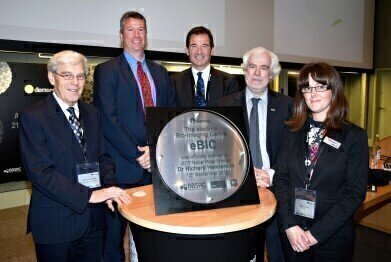-
 : L to R Dr Richard Henderson, Laboratory of Molecular Biology, Cambridge and one of the recipients of the 2017 Nobel Prize for Chemistry winner; Dan Shine, Senior Vice President, Thermo Fisher Scientific; – Professor Andrew Harrison, CEO Diamond Light Source; Professor Dave Stuart, Life Sciences Director at Diamond and MRC Professor of Structural Biology at University of Oxford; and Katie Cunnea, the Electron Bio-Imaging Centre's (eBIC's) Senior centre coordinator
: L to R Dr Richard Henderson, Laboratory of Molecular Biology, Cambridge and one of the recipients of the 2017 Nobel Prize for Chemistry winner; Dan Shine, Senior Vice President, Thermo Fisher Scientific; – Professor Andrew Harrison, CEO Diamond Light Source; Professor Dave Stuart, Life Sciences Director at Diamond and MRC Professor of Structural Biology at University of Oxford; and Katie Cunnea, the Electron Bio-Imaging Centre's (eBIC's) Senior centre coordinator -
.jpg)
News & Views
Centre Provides Industrial Access for Structural Biology Research
Oct 15 2018
The launch of a new cryo-EM capability for use in the life sciences industry sector by Thermo Fisher Scientific and Diamond Light Source the UK’s national synchrotron, was announced in September during the official opening of the new national electron bio-imaging centre (eBIC) at Diamond.
Professor Dave Stuart, Life Sciences Director at Diamond and MRC Professor of Structural Biology at the University of Oxford, Department of Clinical Medicine said: "Access to 21st century scientific tools to push the boundaries of scientific research is essential for both academia and industry and what we have created here at Diamond is truly unique in the world in terms of size and scale. The new centre offers the opportunity for almost real-time physiology, capturing proteins in action at cryo-temperatures by flash-freezing them at various stages. What Diamond has created with eBIC is an integrated facility for structural biology, which will accelerate R&D for both industry and academic users. The additional advanced instruments made available by Thermo Fisher will position the UK as a global leader in providing large-scale industrial access to cryo-EM for drug discovery research. Our new collaboration provides a step change in our offer for industry users and helps ensure that R&D remains in the UK.”
The collaboration has brought the installation of a Thermo Scientific Glacios Cryo TEM and a Thermo Scientific Krios TEM to eBIC, with the two organisations providing cryo-EM guidance and expertise in sample preparation, cryo-EM sample screening and high-end data collection.
“Researchers at leading pharmaceutical companies are already using instruments from Thermo Fisher Scientific to drive impactful research that can help speed the path to understanding and treating viruses and diseases,” said Mike Shafer, President, Materials and Structural Analysis, Thermo Fisher. “The combination of the expert staff members at eBIC and Diamond, alongside these new Thermo Scientific cryo-EM instruments, ensures these researchers are on the cutting edge of discovery.”
The new microscopes will add to the facility’s four existing high-end instruments, which will continue to support the academic demand for both basic and applied science. With its wider research community led by Birkbeck College and Oxford University, Diamond was able to established a centre embedded within the synchrotron's infrastructure through a strategic grant from the Wellcome Trust, Biotechnology and Biological Research Council and Medical Research Council.
The new centre was officially opened on September 12 by Dr Richard Henderson from the Laboratory of Molecular Biology, Cambridge. Dr Henderson is one of the recipients of the 2017 Nobel Prize for Chemistry for developing the cryo-EM technique.
“Using single particle cryo-EM, researchers can now visualise biomolecules at near atomic resolution. This technology has taken biochemistry into a new era, allowing atomic structure determinations of many protein and other macromolecular building blocks that were previously very difficult or impossible to obtain. The technique also opens up high resolution studies of macromolecules in their cellular context through the use of electron cryotomography. Coupling these techniques with the capabilities at Diamond creates a unique environment that will help keep the UK at the forefront of world-leading science,” Dr Henderson said.
Digital Edition
Lab Asia 31.2 April 2024
April 2024
In This Edition Chromatography Articles - Approaches to troubleshooting an SPE method for the analysis of oligonucleotides (pt i) - High-precision liquid flow processes demand full fluidic c...
View all digital editions
Events
Apr 17 2024 Tokyo, Japan
Apr 22 2024 Marrakech, Morroco
Making Pharmaceuticals Exhibition & Conference
Apr 23 2024 Coventry, UK
Apr 23 2024 Kintex, South Korea
Apr 23 2024 Seoul, South Korea








.jpg)








